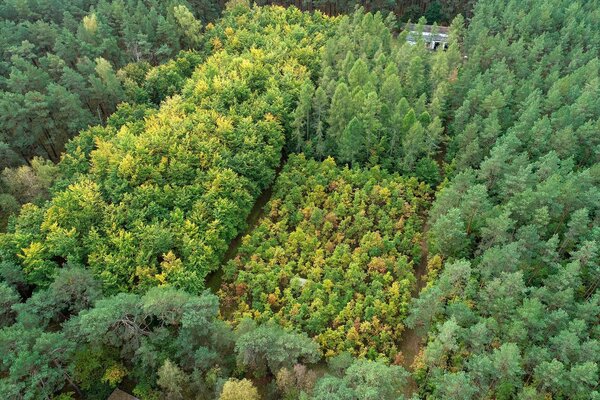Experimental Station Britz
The Britz intensive monitoring site near Eberswalde has been used for almost 50 years to quantify the water consumption of growing main tree species in pure and mixed stands and their influence on groundwater recharge and the landscape water balance. Their location is representative for large parts of the north-eastern German lowlands.
In 1972, nine large lysimeters were constructed with a surface area of 100 m2 (10x10 m) and a depth of 5 m, as required for forest lysimeters. In 1974, these lysimeters, together with a 0.3 ha surrounding area, were planted with the tree species beech (2 lysimeters), pine (3 lysimeters), larch and Douglas fir (2 lysimeters each) in standard associations.
In the years 1999 and 2000, beech trees were planted in one pine and one larch stand, oak trees were planted under one pine stand, and one larch stand was converted into an oak stand. Since the late 2010s, the Douglas fir stands, which had been thinned by storm damage, have been undergoing restoration, with various planted deciduous tree species developing alongside natural regeneration.
In addition to the lysimeters, the station is equipped with other devices for recording water and material flow, which are correlated with meteorological parameters and growth surveys of the most important above-ground tree compartments. The processes are examined at plot level and transferred to the stand level via quantified structure-process relationships. The results are important for forest conversion in the context of future-oriented forest management, taking into account the water management services of forests. A further focus is on investigations into the effects of drought on the growth and water balance of trees.
All information on the Britz intensive monitoring area can be found on the following website:
Website Thünen intensive monitoring area Britz
and on our Thünen Britz App:
Thünen Institute of Forest Ecology / App intensive monitoring area Britz
and on the page
Contact

- Phone
- +49 3334 3820 339
- tanja.sanders@thuenen.de
Head of Ecology and Forest Dynamics, Contact person Intensive Forest Monitoring

![[Translate to English:] [Translate to English:]](/media/_processed_/9/2/csm_Allgemein_Thueringen_Hainich_Mischwald_Bolte_2__19d9dab56a.jpg)
![[Translate to English:] [Translate to English:]](/media/_processed_/d/2/csm_100_0001_0013_c05c63e7db.jpg)






